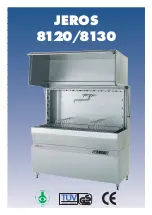
Keep your detergent fresh and
dry. Under the sink isn’t a good
place to store detergent. Too much
moisture. Don’t put powder
detergent into the dispenser until
you’re ready to wash dishes, either.
(It won’t be fresh OR dry.)
If your powder detergent gets old
or lumpy, throw it away. It won’t
wash well. Old detergent often
won’t dissolve.
If you use a liquid dishwasher
detergent, these precautions are not
necessary because liquid detergents
don’t “lump” as they age or come
in contact with water.
You’ll find two detergent
dispensers on the inside door of
your dishwasher. Two, because
some cycles use two washes.
I
~/ \
See
Usage Guide’’ below.
(Be sure
Cycle Indicator Dial
is at
before adding
detergent. Otherwise, the detergent
cup lid will not close and latch
properly )
Always close the main cup
it is firmly latched you will
hear a clicking sound. Do not
NOTE: Detergent cup may be
opened manually
no harm.
Turn handle counterclockwise until
releases. A snapping sound is
normal when it opens.
to prepare
the dishes for
If this is your first dishwasher, or
if you’re replacing a much older
model, you may wonder how much
preparation your dishes need.
Actually very little. Pre-rinsing of
normal food soils is not necessary.
With common sense and a little
practice you’ll soon know what
foods to remove. Here are some
guidelines:
1. Scrape off bones, seeds, skins,
toothpicks and other hard solids. It
is also best to remove hard shelled
vegetables, meat trimmings, leafy
vegetables and crusts. Remove
excessive quantities of oil or
grease.
2.
Remove large quantities of any
food. Your dishwasher has a built-in
soft food disposer that pulverizes
soft food bits and flushes them away.
It can handle
amounts of
soft foods, but large amounts will
be difficult to handle.
3. Try to remove food scraps and
dishes in dishwasher before
soil has a chance dry and become
hard. Dishes with dried-on soil are
more difficult to wash and may
not come clean in the NORMAL
WASH cycle. Remember to use
your RINSE HOLD cycle for small
“holding” loads.
Note: The foods mentioned here
are
examples only. Other foods
not mentioned may also need to be
removed from your dishes. You
may also want to consider removing
foods such as mustard, mayonnaise,
vinegar,
juice and other
foods that can cause discoloration
of stainless steel if allowed to
remain on dishes for a long period
of time.
When using the
PANS
cycle, less preparation is required
before loading. The POTS & PANS
cycle can wash heavily-soiled
dishes and remove dried-on and
baked-on soils from pots, pans and
casseroles. Items with burned-on
soils may not come
And the
dishwasher cannot remove burn
marks or restore fading caused
by overheating during cooking.
Guide (powder or liquid)
SOFT WATER
MEDIUM WATER
HARD WATER.
(O-3 grains hardness)
(3-7 grains)
(7-12 grains*)
CYCLES
Main Cup
Open Cup
Main Cup
Open Cup
Main
Open
PANS and
1 Tablespoon 1 Tablespoon
Half Full
NORMAL WASH
Full
Completely
minimum
minimum
Full
ENERGY SAVER cycle
1 Tablespoon
None
Half Full
None
Completely
None
minimum
Full
RINSE HOLD cycle
Use no detergent
Use no detergent
Use no detergent
*12 grains and up is extremely hard water. A water softener is recommended. Without it,
lime can build up in the water valve. The water valve may stick while open and cause flooding.
Main Cup holds 3 tablespoons; Filled Open Cup holds 2 tablespoons.
7


































